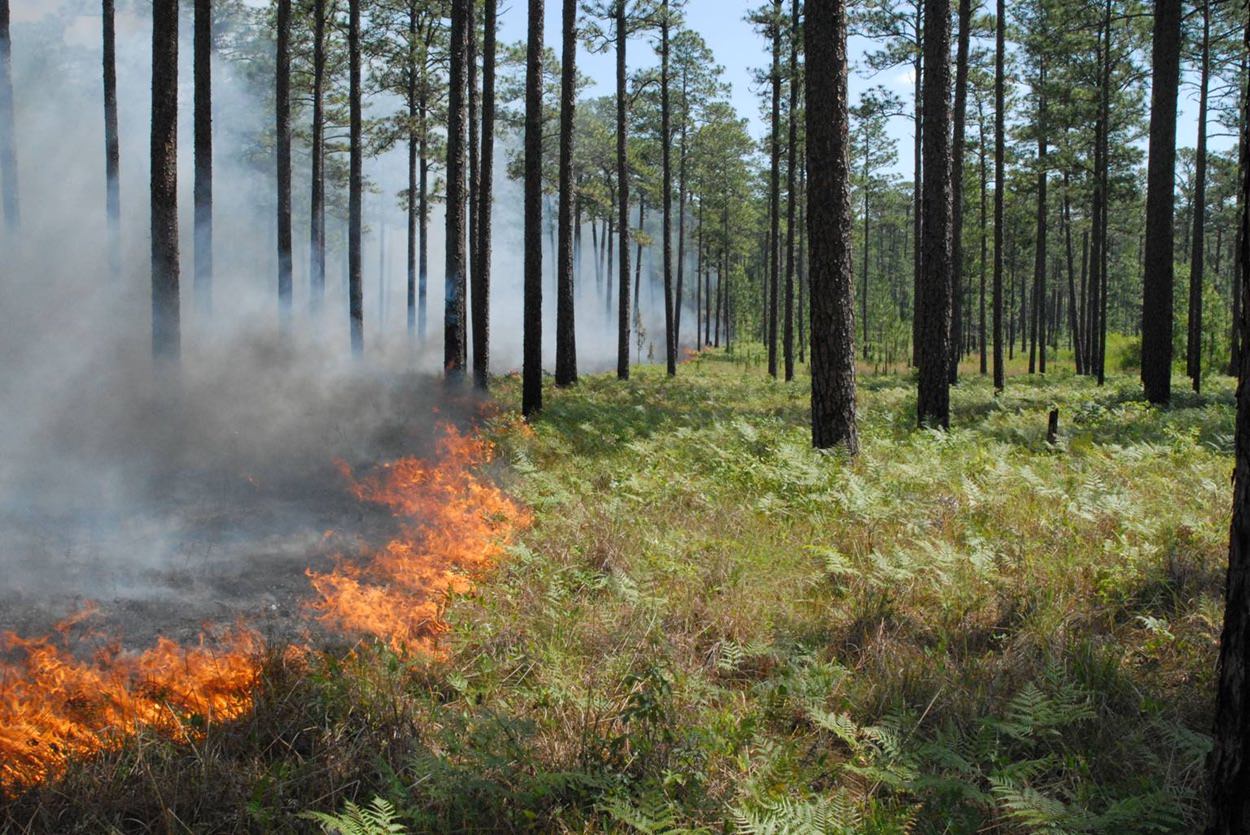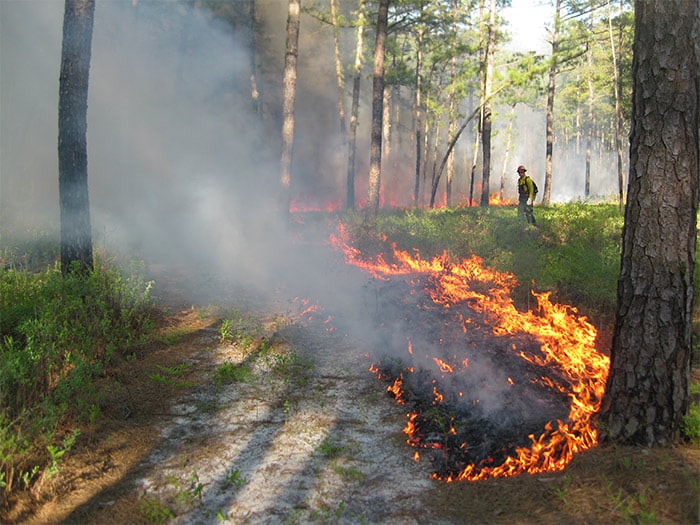uncover
Importance of Fire
"I have a question. We keep talking about fire being important for the longleaf pine forest ecosystem, but I thought forest fires were bad. So are fires in forests good or bad?"
Longleaf pine forests are what we consider a fire dependent ecosystem, which means that the forest actually depends on regular, low-intensity fires to maintain the ecosystem. These types of fires, which are controlled and where there isn't a lot of stuff to burn on the forest floor, are good.

Ingredients for a Fire
Fires need three things to burn - oxygen, heat, and fuel. Think about a campfire - you build the stack of firewood, you light a match, and then you fan the flame to help it catch and grow. How big the fire gets depends on how much wood or fuel you add to it.
A fire in the forest needs the same things. The heat can come from lightening or it be a spark created by people (accidentally or on purpose). The fuel in a forest is the plant material that is available to burn on the forest floor.



If you guessed a fire in forest #1 would burn bigger and hotter, you are right! Forest #2 mostly has low grasses and plants, which will burn quickly then go out.
Guess what type of forest #2 is? A longleaf pine forest!
Why is fire important for the longleaf forest?

When you were exploring species that live in the longleaf forest, you may have noticed that many of the plant species require lots of sunlight to grow. In turn, many animal species depend on these plants and a wide open forest. Without fire, shrubs and young trees would grow up across the forest floor, eventually creating too much shade for the other grasses and flowers to survive. This would change the ecosystem of the forest.
But with regular fires (every 1-5 years), shrubs and young trees don't get a chance to grow too high, so the forest floor remains open and sunny.
Frequent fires also mean that fuel or dead plant material doesn't get a chance to build up in the forest, so fires burn fast. The bark of the longleaf pine trees is thick so they aren't harmed by these fires. Many animal species that live in this forest have good hiding places to avoid being hurt by the fire. And, the important plants growing on the forest floor depend on fire to grow or regenerate.
So, fire is important because it maintains the habitat conditions needed by everything that lives in the longleaf pine forest!
Prescribed & Controlled Fires
Historically, when longleaf pine forests stretched across the southeastern US, fires burned regularly as a result of lightning strikes or controlled burns managed by the native people who lived on the land. After the native people were removed, and the landscape was changed by cutting the forests and building houses and roads, natural fires were suppressed. But today forest managers conduct 'prescribed' burns in longleaf forests. Have you ever gone to the doctor and they prescribed medicine to make you feel better? Same idea! Forest managers prescribe fire to keep the ecosystem functioning. They do this by setting and controlling fires in small sections of the forest at a time. These fires are managed by professionals who keep the forest and the surrounding community safe.

Fear of Fire & Fire Suppression
Many people are afraid of fire - and for good reasons! Fire is a naturally destructive element that can hurt and kill living things and cause great damage. When people started building homes in and close to forests but stopped actively managing the land, and when people were afraid of losing valuable lumber, fire became perceived as a bad thing that we should prevent and be afraid of.
For decades, people and government agencies put a lot of work into preventing and 'suppressing' fires that would have otherwise naturally burned and kept fuel levels low on forest floors. This 'fire suppression' has led to some of the really damaging wild fires we have seen in the news, particularly in the Western US, because there is so much fuel in the forest to burn. These big scary fires have increased people's fear of fires.
But it's important to remember (and to remind others) that not all fire is bad and scary. In fact, in places like the longleaf pine ecosystem, fire is important and necessary if we want to protect the species that live there.

Fire Regeneration
When a longleaf forest burns regularly, it burns low and fast, and the forest floor starts growing or regenerating very quickly. Watch this timelapse video to see how quickly a longleaf forest in Georgia regrew after it burned.